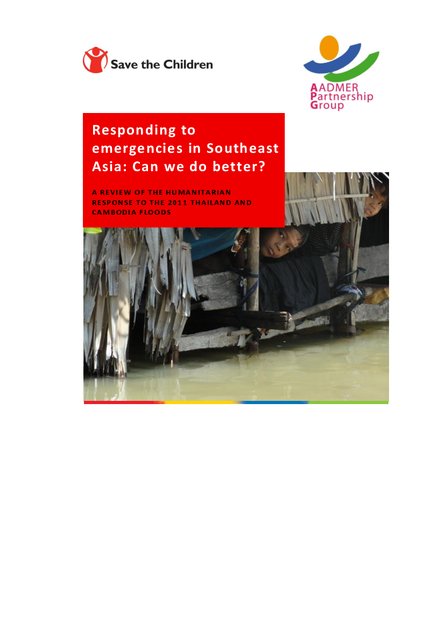
Between July and October 2011, a succession of cyclones, tropical storms and intense monsoonal rains across Southeast Asia resulted in the worst flooding in the region in more than a decade. In Thailand, more than 14m people in 65 provinces were affected; in Cambodia, more than a million people in 18 provinces. By the time the flood waters began to recede, more than 20m people across the region, including 10m children, had been affected.
In both Thailand and Cambodia, as throughout the region, the capacity of national governments to respond to disasters has increased in recent years. Both countries have national disaster management organisations and, to varying degrees, legislative/regulatory and policy frameworks for disaster management. But in the 2011 floods response, adherence to these frameworks proved challenging. In Thailand, an ad hoc body was established to oversee the management of flood relief operations, leaving the Department of Disaster Preparedness and Mitigation (DDPM) with a supporting role. In Cambodia, the National Committee for Disaster Management (NCDM) declined to assume the leadership role that it had in the past vis-à-vis international actors, citing lack of resources and in some cases referencing the absence of a formal government appeal for international assistance.
Consistent with emerging regional practice, neither the Thai nor Cambodian governments made a formal appeal for international assistance. But both governments made it clear that they would welcome assistance, and post-floods, a number of requests were made by various government ministries and departments to international agencies. This should have been sufficient to enable international actors to step in and provide targeted support to complement national capacities so as to ensure a fast, effective humanitarian response. Instead, it gave rise to some uncertainty amongst international actors, and in some cases also amongst national disaster management authorities, regarding roles and responsibilities. Many donor policies state that humanitarian assistance will be provided on the basis of an appeal; and most international humanitarian leadership and coordination structures also assume the existence of a formal appeal. The uncertainty that this created in the response to the 2011 floods resulted in a slower, less efficient response to those in need of humanitarian assistance, and highlights the need for tools and guidelines tailored to suit this ‘welcome but not request’ scenario.
The Asia-Pacific region is the most disaster-prone region in the world. Floods occur more often than any other type of disaster, and in recent decades have increased in frequency as well as severity of impact. The risk will likely be further amplified in the coming decades due to the effects of climate change. In this context, there is a growing imperative to ensure that disaster management systems are fit for purpose, and that capacities at all levels – national, regional and international – are maximised so that when a disaster does occur, aid is provided where it is needed, when it is needed, to those who need it most.
